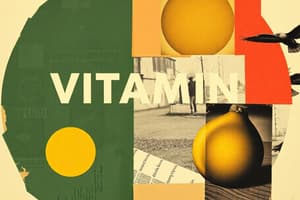Podcast
Questions and Answers
What are vitamins?
What are vitamins?
Tasteless, organic compounds required in small amounts that regulate metabolism, help convert energy, and promote growth and reproduction.
Vitamins play an unimportant role in maintaining health.
Vitamins play an unimportant role in maintaining health.
False (B)
In what groups do vitamins work?
In what groups do vitamins work?
Groups
How many water-soluble vitamins are there?
How many water-soluble vitamins are there?
Which vitamins are classified as fat-soluble?
Which vitamins are classified as fat-soluble?
What influences a vitamin's solubility?
What influences a vitamin's solubility?
Fat-soluble vitamins are absorbed directly into the bloodstream.
Fat-soluble vitamins are absorbed directly into the bloodstream.
Where is Vitamin A mainly stored?
Where is Vitamin A mainly stored?
What happens to excess water-soluble vitamins?
What happens to excess water-soluble vitamins?
Vitamins can be destroyed during cooking or storage.
Vitamins can be destroyed during cooking or storage.
What are free radicals?
What are free radicals?
Which of the following are considered antioxidants?
Which of the following are considered antioxidants?
What are the dangers of free radicals?
What are the dangers of free radicals?
Match the following antioxidants with their sources:
Match the following antioxidants with their sources:
Phytochemicals are synthetic compounds.
Phytochemicals are synthetic compounds.
Why are vitamins found widely in food groups important?
Why are vitamins found widely in food groups important?
Flashcards are hidden until you start studying
Study Notes
Vitamins: Definition and Functions
- Tasteless, organic compounds required in small amounts for various body functions.
- Regulate metabolism and convert energy from fats, carbohydrates, and proteins into ATP.
- Promote growth and reproduction; deficiencies can lead to serious health issues.
- Excess intake of certain vitamins can be toxic.
Vitamin Classification
- Vitamins are grouped based on solubility into:
- Nine water-soluble vitamins: B vitamin complex and Vitamin C.
- Four fat-soluble vitamins: Vitamins A, D, E, and K.
Influence of Solubility
- Solubility affects:
- Digestion, absorption, transportation, storage, and excretion of vitamins.
Absorption and Storage Differences
- Both fat-soluble and water-soluble vitamins are absorbed in the small intestine.
- Fat-soluble vitamins require fat for absorption and can accumulate in the body, potentially leading to toxicity.
Fat Soluble Vitamins Characteristics
- Released from food with proteins in the stomach and absorbed in the duodenum, then transported via lymph into the bloodstream.
- Stored mainly in the liver (Vitamin A) or fat/muscle tissue (Vitamin D) but can accumulate to toxic levels.
Water Soluble Vitamins Characteristics
- Absorbed along with water directly into the bloodstream, predominantly in the duodenum and jejunum.
- Not stored; excesses are excreted in urine, necessitating daily intake.
Vitamin Stability During Cooking/Storage
- Vitamins can be destroyed by exposure to oxygen, light (especially UV), water, heat, changes in pH, and during the preservation of fruits and vegetables.
- Fat-soluble vitamins tend to be more stable compared to water-soluble vitamins.
Antioxidants
- Compounds that neutralize free radicals to counteract cellular oxidation.
- Includes Vitamin E (fat-soluble), Vitamin C (water-soluble), selenium (mineral), flavonoids, and carotenoids.
Free Radicals
- By-products of metabolic reactions, unstable molecules with unpaired electrons.
- Caused by UV light, smoking, and environmental pollutants.
Dangers of Free Radicals
- Accumulation leads to oxidative stress, damaging DNA and proteins, affecting cell structure.
- Contributes to chronic diseases such as heart disease, diabetes, Parkinson's, Alzheimer's, cancer, and aging.
Oxidation Processes
- Some free radical damage is preventable, while certain oxidative stress is inevitable due to natural aging and environmental factors.
Role of Antioxidants in Health
- Antioxidants, including certain phytochemicals, also stimulate the immune system and may prevent cancer.
- They are primarily found in plant foods and believed to offer more health benefits than supplements.
Importance of Dietary Sources
- Emphasis on obtaining vitamins and antioxidants from food sources rather than supplements for optimal health benefits.
Studying That Suits You
Use AI to generate personalized quizzes and flashcards to suit your learning preferences.




